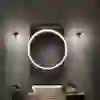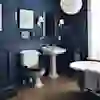Share:
The best bathroom lighting will make your dream bathroom shine. A fantastic choice of bathroom lighting balances purpose with ambience. Yet, as a wet space, the nature of the bathroom environment is harsh. So, it's not possible to use any old light fitting in a bathroom.
All bathroom lighting needs to be bathroom friendly. Ultimately, bathroom electrical safety should be the top priority.
Here, The Bathroom Showroom explains IP ratings and bathroom zone requirements. This will help you understand and select the correct bathroom lights.
What Are Bathroom Zones?
When discussing bathroom lighting, we refer to areas in this room as zones. This is simply to identify how much water is likely to be present in specific places of the bathroom. We can then use these zones to inform us what light fitting is the safest choice here.
By getting an idea of the proximity of the light to the water, working in bathroom zones prevents electrocution in the bathroom.

The main bathroom zones include:
Zone 0
This is the area in the bath tub, shower enclosure, and basin. In this area, light fittings will most likely come into contact with water or be submerged in water.
For zone 0, light fittings need to be at least a minimum of IP67 which means immersion proof. Lights used in zone 0 will also need to be low voltage, with a maximum of 12V.
Zone 1
This is the area of the bathroom that is directly above the bath tub and the shower, up to a height of 2.25m from the bathroom floor and at a 1.2m radius from water sources. Though such areas won’t be submerged in water like those in zone 0, they will likely be exposed to water spray and condensation.
For zone 1, light fittings with IP44 are minimum requirements here, with IP65 choices recommended.
Zone 2
Referring to a larger surface area, zone 2 covers the area outside of the bath, shower, and basin. Essentially, zone 2 will extend zone 1 by another 60cm.
This area covers a height of 2.25m from the bathroom floor and will likely experience occasional splashes and light sprays of water.
Light fittings in zone 2 require a minimum of IP44.
Outside Zones
Formally known and referred to as zone 3, outside zones are areas beyond zones 0, 1, and 2. The outside zone is essentially used to reference any area in the bathroom that doesn't fall under the main 0, 1, and 2 zones.
Though normal safety rules apply for light installation here, outside zones don’t have to adhere to a specific IP rating.

What is a Bathroom IP Rating?
When shopping for bathroom lights, you’ll regularly come across a section of numbers on these fittings that begin with the letters IP in front of them.
IP, or Ingress Protection to give it its full name, is a code used as a rating for the level of protection of the light choice. Each light will be tested to determine its resistance against solid objects and liquids.
The first number of the IP rating references the light's protection against items such as dust while the second is against water. The higher the number of the IP, the more protection the light will offer in the bathroom.
What IP Rating Is Suitable for Bathrooms?
You’lll need to refer to the zone when selecting the most suitable IP rating for bathroom lights. However, the two most common choices for UK Bathrooms include IP44 and IP65.
- IP44 - This IP number tells us that the light fitting has limited water resistance.
The first number 4 states the protection level against solids of up to 1 mm square.
The second 4 tells us the protection level of water splashes.
The Bathroom Showroom offers a wide selection of IP44-rated bathroom lights from the HiB range. With a selection including Rhythm, Polar, Horizon, and Lumen, these are stunning additions to any bathroom and work well for all decor and bathroom tasks.
- IP65 - This IP number tells us that the light fitting is water-resistant.
The number 6 states the total protection level against dust.
The number 5 shows the protection against low-pressure jets of water.
The Pro Light downlight from The Bathroom Showroom is a fantastic example of an IP65 light fitting. With the ability to dim this light and switch between warm white, white, and daylight, this is the ideal choice for zone 2.

Do Bathroom Lights Need to Be IP Rated?
It’s crucial that the bathroom lighting you choose is safely installed in your bathroom. When you’re aware of the correct IP ratings, you’ll find it easier to select the best choices for all areas of this room.
Though it’s not advisable to go below the recommended IP rating, it’s okay to select a higher IP than necessary.
When your light choices meet safety regulations, you can enjoy a bathroom that provides perfect lighting for every task and mood for many years to come.
If you’re considering adding bathroom lighting, book an appointment with The Bathroom Showroom. Experts in all things bathrooms, we can help turn your dream bathroom into a reality.
